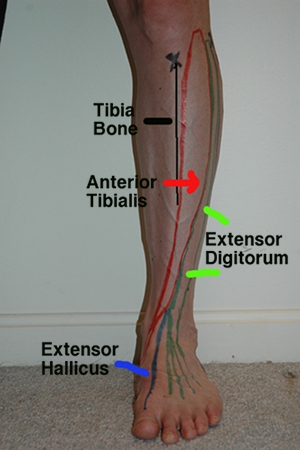Shin Splints
As you may recall from our intro post on kinesiology taping, we’re going to focus on each muscle group/joint and show you how to use kinesiology tape in three distinct ways:
- Immediately after injury (for swelling and pain)
- During the healing process (correction techniques to restore normal position and allow for healing)
- Techniques to help improve strength + function
In this post, we’ re going to be talking about a taping application designed to decrease the amount of pull on the Anterior Tibialis. This is perfect for recovering muscles and tendons where you want to provide support and allow for rest so that the injured muscle/tendon can heal. The Anterior Tib is a commonly injured muscle with shin splints (aka tibial stress syndrome). This is a repetitive overuse injury that can be caused by tight calves and ankles, improper footwear, or abnormal mechanics (i.e. running/cycling form).
This type of application is called an inhibition technique. The key for using it is to use the anatomy! Remember, the tape is specifically made to pull on itself. That is what the weird spirals and shapes are when you look at the back of the tape. When trying to inhibit the muscle, you want the tape to move from the muscle insertion to origin so that when the tape pulls on itself, it results in an eccentric pull (eccentric = lengthening of the muscle). This is ideal for trying to diminish the contraction which will allow for rest and more importantly recovery.
Anatomy
The anterior tibialis is one of the easiest muscle to find in the lower leg. Start with your fingers on the shin bone and slide off the bone towards the outside of the leg. The first muscle you feel is the AT. It starts just below the knee on the tibia, runs down the front of the leg and then wraps across to the inside of the ankle. It is responsible for pulling the ankle up (dorsiflexion) and in (inversion). You can read more about the anatomy and surrounding muscles here.
What you will need:
1) Roll of kinesiology tape
2) Sharpest scissors in the house.
Prep work:
1) Clean skin. This means no oils or lotions of any kind. You want your skin to be clean and more importantly dry. Moisture of any kind = tape will fall off or fail to stick altogether.
2) Hair care. Ideally, the less hair the better. Guys, this means that for best results you will need to trim any long leg hair or shave the calf area.
3) If clean, dry, and hairless skin still = no sticking of tape. Time to get some adhesive spray like Tuf Skin.
4) The tape should last 3-5 days. You can get it wet and shower with it on. Just towel dry it after. No hair dryer! The tape is heat activated.
Taping Techniques
1) Inhibition technique for the anterior tibialis with correction strip.
Key Points:
- Prep the skin first. For this application you will want to put the foot and ankle on stretch (pull the toes down and in; this is similar to the position your foot would be in if you caught the outer edge of your foot and rolled your ankle).
- There will be two strips for this application. The first will be anchored just below the pinky toe and then the two tails placed without without stretch (the first wraps under the arch, over the the top of the foot and then up the anterior tibialis muscle. The second tail follows this path but stays closer to the shin bone. Both tails are applied without stretch. Simply lay the tails down. The tape works by pulling on itself and you have already put the muscle on stretch to do the work for you.
- A secondary correction strip can be applied to any specific sore spots. Cut the tape so that it is long enough to cover the painful area with 1-2″ of tape on either side (these are your anchors and must be applied without stretch). Round the edges, apply 50-75% stretch and place the tape. Then remove the paper backing and lay down the ends. Don’t sweat the 50-75%. Think medium stretch versus maximum “how far can I pull this tape” kind of stretch.
- See the video above for full details.
- For further instructions on how to incorporate kinesiology taping into your self treatment regimen click here.
References
1) Capobianco, Dr. Steven and van den Dries, Greg. (2009). Power Taping, 2nd Edition, Rock Tape Inc, Los Gatos, CA.
2) Hammer, Warren. (2007). Functional Soft-Tissue Examination and Treatment by Manual Methods, 3rd edition. Jones and Bartlett Publishers, Inc, Sudbury, MA.
3) Kase, Kenzo, Wallis, Jim, and Kase, Tsuyoshi. (2003). Clinical Therapeutic Applications of the Kinesio Taping Method.
4) Muscolino, Joseph. (2009). The Muscle and Bone Palpation Manual. Mosby, Inc, St. Louis, MO.












